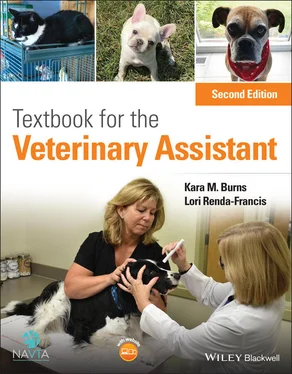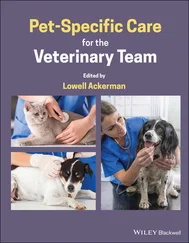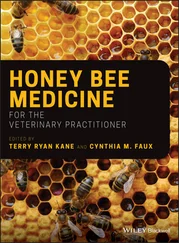The patient’s information is obviously an important section of the record. The form should include details regarding species, gender, neutered status, date of birth, breed, and color. It is important for team members to know the breeds within a species (see Chapter 7) as owners can be easily offended when team members are unfamiliar with the pet’s breed or guess incorrectly. Be sure the documents are scanned into and become part of the patient’s medical record, especially if a signature is included indicating the client agrees to payment terms.
Every animal that is seen at the veterinary hospital should have its own medical record. The record should be dated each time an entry is made; the presenting problems should be listed, and the author must initial this entry. Veterinary hospitals vary – they may use paper medical records, be paperless, or paper light. Paper medical records must be kept on 8½ × 11 in. sheets of paper. It is important to note that index cards are no longer acceptable as the medical record. Every client interaction, every client conversation, consent form, laboratory report, consultation, physical examination, and medication administered and dispensed must be documented in the medical record. If it is not in the patient’s medical record, then “it never happened.” Many veterinary hospitals have moved to paperless medical records. Paperless hospitals have the benefit of being able to access client records, laboratory results, and radiographs at any computer station.
There are also a number of consent forms which pet owners may be asked to sign before various treatments and procedures can be performed on their pets. Every member of the veterinary team must be able to explain the meaning of every form that a client is asked to sign. It is important for team members to also read the consent forms aloud to the client, helping to ensure the client understands what he or she is signing. Consent forms are not required by law – their purpose is to protect the veterinary health‐care team. If the form is documented in the record, it can be submitted if a court case arises. If the form or conversation is not documented, the assumption is that the risks, benefits, or information were never discussed or provided. Again, “it never happened” if it is not in the medical record. Be sure all consent forms have the owner’s and patient’s name(s) along with the date and the initials of the team member helping the client sign the forms.
Rabies certificates today are often generated by the veterinary software system utilized by the hospital. The team member enters the rabies tag number, lot number, and manufacturer of the vaccine. Lot numbers or serial numbers of vaccines are crucial information and must be entered in the event of a recall. This information allows for hospitals to identify who received the recalled vaccine. The practice management software automatically populates client and patient information; veterinary signature and license numbers must be added to all printed certificates.
If a handwritten rabies vaccine book is used by the practice, the correct owner and patient information must be legible. The following information is required:
date
owner’s name
owner’s address
owner’s phone numbers
patient’s name
patient’s age
patient’s breed
patient’s gender.
The rabies tag number and lot number are then entered, in addition to the veterinarian’s signature and license number. It is imperative to ensure the information has been added correctly and legibly, as often the rabies tag and number help to identify lost pets.
Spay or neuter certificates
Once a patient has been neutered or spayed, a certificate is generated which provides the owner with proof that the pet has been neutered. There are times when city or county ordinances require that a pet is neutered and this certificate is proof.
When traveling with pets, airlines and various state and federal agencies require health certificates. Airlines want to ensure the pet is healthy and has seen a veterinarian prior to accepting the pet for transport. States want to ensure the pet is not importing any diseases if they are coming from a different state. Both federal and state agencies are responsible for the prevention of disease and have various regulations regarding the entry of animals. The majority of interstate health certificates are good for ~10 days before shipment.
The pet must be fully examined by a veterinarian before the certificate is issued. The majority of the states in the nation require compliance with providing a copy of the health certificate. International health certificates are typically good for 30 days and require the signature of the state veterinarian. These certificates pertain to shipping pets out of the United States. Both forms of health certificates require the owner’s name, address, and phone number along with the name, address, and phone number of the person who will be accepting and taking responsibility for the pet. All the animal’s identifying information must be included, including age, breed, gender, and microchip or tattoo number. The animal’s vaccines must be current, with the vaccination information stated visibly.
Small animal health certificates differ from large animal health certificates. A large animal certificate should disclose tests that are required (by state law) and have been completed – with the results on the certificate. It is important to verify regulations prior to shipping or transporting any animal to another state or country.
A veterinary team member must review invoices with owners before collecting money. Services that have been provided should be detailed, and the team member should anticipate questions. The invoice should include every aspect of the services provided. Allow the client to review the invoice in detail after the team member explains the charges. Also, allow the client to ask questions. This detailed presentation allows the client to read and understand the services and charges. The value of client service can be increased when all procedures are explained thoroughly.
Most veterinary hospitals commonly accept payment in the form of cash (including debit card), check, or credit card. It is important to ensure that the signature on the credit card matches the signature on the receipt. The Federal Trade Commission created the Red Flags Rule which states that any credit card transaction should be verified with a picture identification. This rule was established to help decrease fraud and the use of stolen credit cards.
Another option for pet owners is pet health insurance. Many policies are set up so that the owners pay the hospital for the services their pet needs and are then reimbursed by the insurance company.
CareCredit is a health‐care financing credit card that can be used for veterinary services. Clients can apply either online or while at the practice. A veterinary team member can enter the client’s information online or through a telephone operator. Typically, the approval is received quickly – sometimes within 10 minutes. For more information, visit www.carecredit.com/vetmed.
In today’s society, accepting cash has risks as cash can be counterfeit. Detecting counterfeit money is not easy. Best practices state having the local police department notify the hospital team if there has been passing of or suspicion of counterfeit money in the area.
Within the hospital, cash should be kept in a locked safe and out of sight from clients. Unfortunately, many businesses have realized the hard way that it only takes a second for a person to reach over the counter and grab money from the drawer. Cash drawers should have a lock and be locked immediately after they are closed. Never leave a cash drawer unattended, especially if it is unlocked. One moment of inattentiveness can result in the loss of a great deal of money.
Читать дальше












